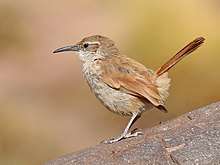Rock earthcreeper
The rock earthcreeper (Ochetorhynchus andaecola) is a species of bird in the family Furnariidae. It is found in the Puna grassland of Bolivia and northern Chile and Argentina. Its natural habitats are subtropical or tropical high-altitude shrubland and subtropical or tropical high-altitude grassland.
| Rock earthcreeper | |
|---|---|
 | |
| Scientific classification | |
| Kingdom: | Animalia |
| Phylum: | Chordata |
| Class: | Aves |
| Order: | Passeriformes |
| Family: | Furnariidae |
| Genus: | Ochetorhynchus |
| Species: | O. andaecola |
| Binomial name | |
| Ochetorhynchus andaecola (d'Orbigny & Lafresnaye, 1838) | |
| Synonyms | |
| |
Description
The rock earthcreeper grows to a length of about 18.5 cm (7.3 in). The upper parts are brown with some rufous colour on the primary feathers and a rufous brown tail, which is often kept cocked. The underparts are pale buff, with brownish streaks on the sides and flanks, and sometimes on the entire breast. The beak is long and slightly decurved, and there is a narrow buff supercilium above the eye.[2]
Distribution and habitat
The rock earthcreeper is native to the eastern foothills of the Andes Mountains, its range extending from La Paz Department in western Bolivia to northern Argentina and the eastern fringes of Chile. Its typical habitats are rocky hillsides, grassland with and scattered trees and bushes, rocky outcrops and ravines at altitudes between 2,600 and 4,200 m (8,500 and 13,800 ft).[2]
Ecology
This species usually occurs singly or in pairs. It forages on the ground, seldom far from rocks, hopping along,[2] and probing gravel and loose soil with its beak. It is often wary and difficult to approach, flying off for considerable distances when disturbed.[3] The song is produced from a perch on a bush or boulder, and consists of a series of loud, shrill notes "vee-vee-vee-vee-vi-veet", sometimes ending with a splutter.[2]
Status
The rock earthcreeper has a very wide range in Bolivia, northern Chile and northwestern Argentina. It is an uncommon bird and the populations seems to be declining, but not at such a fast rate as to make it vulnerable. The International Union for Conservation of Nature has assessed its conservation status as being of least concern.[1]
References
- BirdLife International (2012). "Ochetorhynchus andaecola". IUCN Red List of Threatened Species. 2012. Retrieved 26 November 2013.CS1 maint: ref=harv (link)
- Ridgely, Robert S.; Tudor, Guy (2009). Field Guide to the Songbirds of South America: The Passerines. University of Texas Press. p. 68. ISBN 978-0-292-71748-0.
- Schulenberg, Thomas S.; Stotz, Douglas F.; Lane, Daniel F.; O'Neill, John P.; Parker, Theodore A. III (2010). Birds of Peru. Princeton University Press. p. 302. ISBN 1-4008-3449-X.
- SACC (2007). Reinstate Ochetorhynchus and merge Chilia and Eremobius into it. Accessed 2008-10-28.
